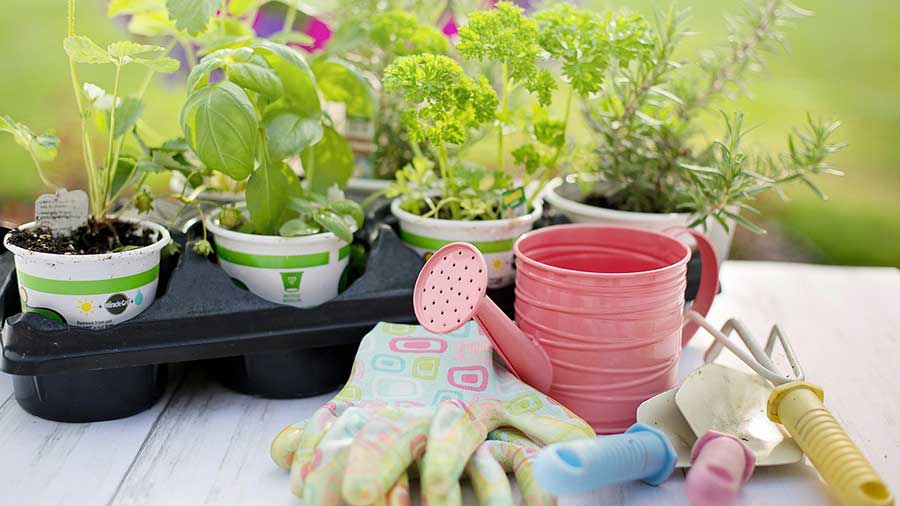Having so many containers I can use for my container garden, I wondered what I can plant in my large container. Well, I decided to plant some nutrient-packed herbs for my kitchen, which is really a good idea. Next, I asked myself, “Which herbs grow well together in a container?”
I did some research and I came down to the conclusion that I can group herbs according to their soil preference. Some herbs like dry soil (even with drought-like conditions), while others like it damp or moist.
Here is a list of herbs that can be grown together in a container
Herbs that like wet, damp or moist soil
- Chives
- Fennel
- Coriander or Cilantro
- Parsley
- Basil
Herbs that can tolerate dry soil or drought-like conditions
- Tarragon
- Lavender
- Oregano
- Rosemary
- Thyme
- Dill
- Sage
Herbs that grow well together in a container with damp or moist soil
Chives
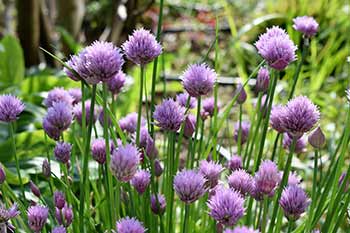
Chives are tiny onions and grown for their flavorful leaves and flowers, which bloom purple. They bloom well in well-drained potting soil with plenty of organic matter. While they can grow well in shade, they thrive best in full sun.
They are usually grown from bulbs and are easy to grow indoors. Both onion and garlic chives can be grown and used in the kitchen to add a punch of flavor to many dishes.
The flowers are edible as well and can be floated in soups. Chives grow best in clumps, and they can be grown in small pots for a container garden. The leaves of onion chives are hollow and the leaves of garlic chives are flat.
Chives plants also have insect-repelling properties and can be used in gardens to drive away unwanted pests.
How to grow chives
Chives can be planted from seeds or divisions. The herb grows best if planted from divisions, which means finding a clump of chives and taking a small portion of that clump to plant in a separate area. Dig up a portion of the clump in early spring or mid-fall and transplant to the desired location. The transplant should have at least five bulbs.
If planting from seed, plant the seed ¼ inch deep and water well. Chives can be grown outdoors or indoors near a window. If planting inside, keep the pot in a dark area until the seeds sprout, and then move to a windowsill. Begin chives indoors eight weeks before the last frost. Transplant chives to the garden when the sprouts reach 6 inches in height.
In addition to growing well in pots, chives are often planted as a border along an herb or flower garden.
Coriander
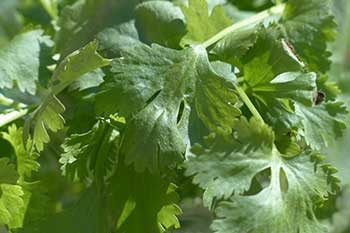
Coriander, sometimes called cilantro, can grow well under some shade but grows best under the sun. Plant in deep containers as it has a long taproot. This glorious herb can be used in many Asian dishes, paired with fish, soups, salads, and even ground into pesto. You can use the whole plant –leaves, stems, roots, and seeds, too.
How to grow coriander
Before planting the seeds, you must prepare them so they will be able to germinate. Coriander seeds are actually two seeds encased in a husk. Crush the husk gently by holding the two seeds together and then soak the seeds in water for 24 to 48 hours. Remove the seeds from the water and allow them to dry before planting.
Coriander can be started indoors or outdoors. Plant the seeds ¼ inch deep. To transplant a coriander plant that has been started indoors, dig holes 3 to 4 inches apart in the garden. After transplanting, water it thoroughly.
Due to coriander’s strong aroma, it rarely has issues with pests and is even considered an insect repellant.
Parsley
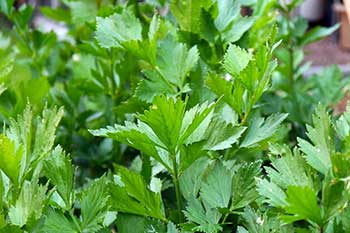
Parsley grows slow. Because it requires low maintenance, however, and can live up to nearly two years, parsley is a good choice for your herb garden. Do not cut the initial leaves. A compact and vigorous plant, it is ideal for garnishes and flavoring.
The nutritious leaves are high in iron and vitamins A, C, and E. The high chlorophyll content makes it a natural breath sweetener, too. Its high chlorophyll content also makes it a natural breath sweetener. It grows well in containers
The entire herb—stem and all—can be used for flavoring stocks, soups, and sauces, but more often the leaves are stripped from the stems and chopped before adding to a recipe. They can be used as an ingredient in recipes such as meatballs and meatloaf or added as a flavoring at the end of cooking.
Whole leaves can be incorporated into salads and used as a garnish.
How to grow parsley
Fill a tray with media or soil mix. Sprinkle with water. Poke the soil. Place 1-2 seeds in each hole, then lightly cover with media. Thin to one seedling per hole when true leaves are already developed.
Transplant or transfer the seedling in the plot or largest pot for the plant to grow. Dig a hole in the soil and place the seedling. Cover the roots with soil and press lightly. Water the seedling after transplanting. Keep soil moist after planting until plants are well-rooted.
When harvesting, cut leaves from the outer portions of the plant and allow the inner portions to mature.
Fennel
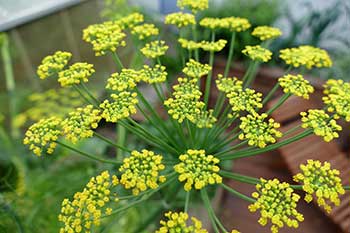
Fennel is a bulbous vegetable with overlapping layers similar to cabbage and long fronds resembling dill. The fronds can be used in salads, but the vegetable is often grown for its bulb, which produces a crunchy texture with a taste similar to licorice. The bulb can be grilled until tender, or sliced thin for use in slaws and salads.
How to grow fennel
As fennel doesn’t transplant well, plant seeds directly in the garden after the last spring frost. Sow them ¼ inch deep and 12 inches apart in rows set 3 feet apart. Plant fennel plenty far away from other garden plants to discourage cross-pollination. To aid in this, plant fennel in pots or in the back of the garden.
To grow: Fennel does best in full sun with rich soil, which produces lush fronds. Until the shoots appear, water only by spraying with a spray bottle. After shoots appear, water frequently so the bulb doesn’t dry out. Fennel may need to be staked once it reaches 18 inches tall, as some plants can grow up to 4 feet.
The bulb grows at the base of the fronds but not underground. Once the bulb begins to develop, blanch the bulb by hilling soil around it to protect it from the sun.
Basil
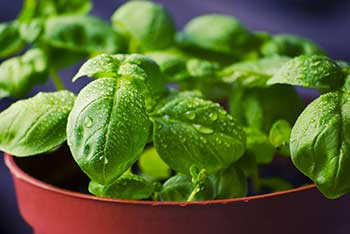
Basil grows best in full sun and fertile, moist soil. Roots come out about six weeks after seeds have been sown. It can tolerate short periods of drought. This herb's name comes from the Greek word "basileus," which means "king." Basil is a cornerstone of the culinary arts, used throughout the world for its fresh flavor. It is best grown in hot and dry environments, and can even grow indoors with sufficient sunlight.
Basil belongs to the mint family. It has 35 varieties, including Thai basil, lemon basil, and holy basil. Basil is what is normally used for cooking
Traditional in a pesto dressing, basil's small leaves have a pungent and delicious flavor. Scatter over any tomato salad, but particularly one with mozzarella cheese.
How to grow basil
Basil grows best in warm weather, and basil seeds should be planted after all dangers of frost have passed. Plant seeds 1/4 inch deep and 12 inches apart. Seeds can be started indoors to get a head start on growing the herb. Plant indoors six weeks before the last frost date and place in a sunny windowsill. Plant in moist soil that is well-drained.
If planting in a container, use a larger pot to prevent plants from drying out in the summer heat.
Basil needs six to eight hours of sun per day. Water the plants freely during dry periods and once flowering begins, pinch off the flower heads to encourage the leaves to continue to grow. Basil does best in soil with a pH of 6 to 7. Since basil likes moisture, place mulch in the pot or around the plants to help retain moisture.
Basil should be pruned once the plant has six to eight leaves. After the basil plant is six weeks old, pinch off the center shoot to keep flowering at bay. Basil grows well if planted near tomatoes in the garden. The biggest threat to a basil plant is root rot from poor drainage, so ensure the planting site has adequate drainage.
Also, watch out for pests such as aphids, slugs, or Japanese beetles.
Herbs that grow well together in a container with dry soil
Tarragon
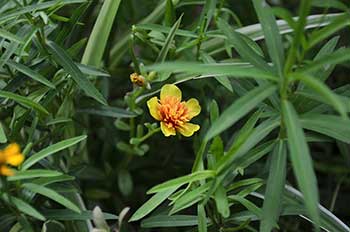
Tarragon can tolerate drought, so it needs no intense watering, especially when planted in a well-drained potting mix. It can also grow under a shade, but prefers full sun. Tarragon is a licorice-flavored herb that is often used to flavor meats or egg dishes. It is used both fresh and dried.
Tarragon is a hardy herb usually grown for its leaves and its aromatic flavor. Tarragon plants can reach up to 3 feet tall. The herb has long, light green leaves and yellow or white flowers.
How to grow tarragon
Tarragon is best grown from cuttings or divisions, but it can be started from seed as well. Begin tarragon seeds indoors in April and sow four to six seeds per pot in moist, composted potting soil. Once seedlings sprout a few inches, thin them to one seedling per pot. Russian tarragon can be grown from seed, but French tarragon is only grown from division, stem cuttings, or layering.
Transplant tarragon seedlings outdoors once the last frost has passed. Tarragon grows best in full sun in soil with a pH of 6.5 to 7.5. Upon transplanting them outside, space tarragon plants 18 to 24 inches apart if planting in the garden. Because of its great root system, tarragon can thrive in poorer soils.
Once the plants have become established, they do not require frequent watering unless there is a drought. Prune the plant frequently to keep it at a preferred height of 2 feet and to prevent flowering.
Spread mulch around the plants in the fall to help them overwinter. If worried about the winter climate, bring tarragon indoors over the winter to continue its growth.
Divide the tarragon plants every three to five years to ensure their best growth. When weeding tarragon, take caution as its root system is shallow and aggressive weeding can damage the plant’s roots. Since most insects and pests dislike tarragon’s aroma, it makes for a good companion plant, especially for eggplant.
In addition to warding off pests, tarragon is known for causing better growth in the companion plants grown near the herb.
Lavender
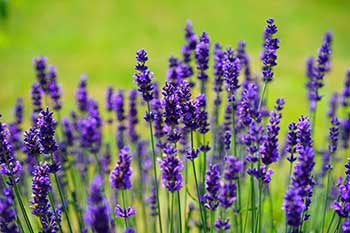
Lavender, like tarragon, can tolerate drought, too. It loves full sun but hates fertilizers. Lavender is most commonly used in aromatherapy. The fragrance from the oils of the lavender plant is believed to help promote calmness and wellness.
It's also said to help reduce stress, anxiety, and possibly even mild pain. Use lavender as a natural pest repellent near patios and porches.
The scent deters mosquitoes, flies, fleas, and other problem insects. Lavender herbs will display purple colored blooms through the summer months, attracting an array of beneficial insects to the garden, such as butterflies, bumblebees, honeybees, and hummingbirds as well. This highly aromatic compact form of lavender is ideal for low hedging, borders, or pots.
Its long-lasting perfumed flowers attract friendly insects, and the grey-green leaf color creates a pleasant contrast in the garden.
How to grow lavender
Plant the seeds in well-drained soil 1/2 to 1 inch deep. The soil doesn't have to be nutrient-rich, but it must be moist. Don't oversaturate and make the soil muddy. Seeds need water when they germinate. Lavender will germinate within 14 to 25 days. Once the seedlings are sprouted, make sure you have plenty of water, although it is not necessary. Lavender can grow well even in a dry environment.
Lavender needs a lot of sun and is best grown in open fields without shade. Even moderate shade can stunt growth.
Oregano
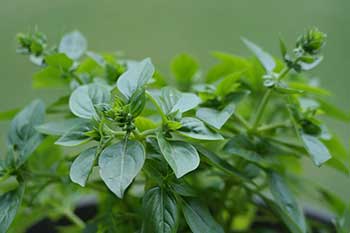
Oregano loves well-draining potting mix and full sun. The more sun it receives, the more pungent the leaves. It doesn't like wet soil. Oregano has a sweet aromatic flavor. With its Mediterranean heritage, it's the ideal herb to use in Italian and Spanish-style dishes.
Oregano is a grab-and-go herb that pairs well with chicken, scrambled eggs, baked eggplant, burgers, and even fish. Grow it in a warm spot outside or keep it in a pot on a sunny balcony.
How to grow oregano
Fill starter trays with Seed raising mix soil. Sprinkle seeds over mix, lightly cover, and gently water. Keep the soil moist throughout germination. Once seedlings reach 10cm tall, fill chosen pots with quality potting mix. Transplant seedling into the pot and water it well with nitrogen-rich water-soluble fertilizer
Rosemary
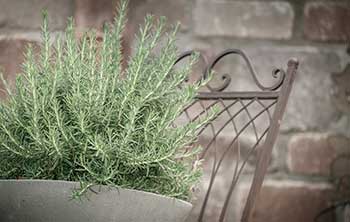
Rosemary loves hot, dry spots and quick-draining soil. It can tolerate drought. Do not wet when grown indoors. It is a slow-growing perennial that will not be ready to harvest in its first year. The herb originated in the Mediterranean so it likes the hot weather. It doesn't only give you fresh herbs to cook with but it is also a pretty bush with a wonderful aroma.
With its fine aroma, the plant branches are used in cookery for the preparation of many dishes for many centuries. The substances which are contained in rosemary improve mood, reduce stress, and helps condition your skin.
How to grow rosemary
Patience and an expectation of low germination are needed for rosemary. Rosemary is hard to start from seed even for professional gardeners, which is why cuttings are the propagation method of choice for most growers. Rosemary germination, under ideal conditions, takes 2 to 4 weeks. Keep the seeds warm and in a dark place when they are sown.
Use the lightest and most free-draining planting medium you can find. Since it takes several weeks to germinate, be sure you have them in a place where they won't get knocked around. A rarely used closet works. This is a little different than other herb seeds that require mid-range temps to germinate.
Dill
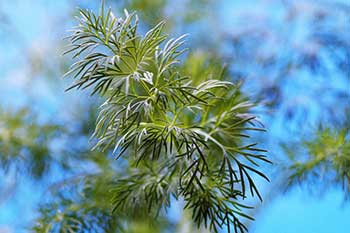
Dill is a popular herb that is used as a seasoning in many different kinds of dishes such as soups, salad dressings, and pickling recipes. It is a fern-like, fragrant plant with a great flavor. In addition to its fragrant foliage, dill also produces yellow blooms that can be used in bouquets, or the green ferns can be used as filler. Dill can reach up to 3 feet tall.
How to grow dill
Dill grows best sown directly into the garden in the early spring after the last frost. To ensure a continuous harvest, plant dill seeds every 10 days up until the early summer. Plant seeds 1/4 inch deep and 18 inches apart. Dill also can be planted in containers, like most herbs, but a deep pot should be used to accommodate for the herb’s deep roots.
Sage
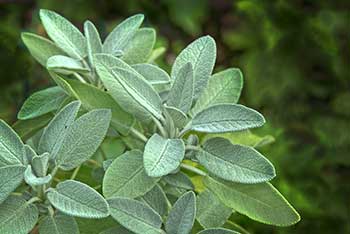
Sage is best grown in full-sun, well-drained potting mix. Sage is a perennial, evergreen sub-shrub, with grayish-green color and lance-shaped leaves. It has a high antioxidant capacity to protect the body’s cells from damage that may lead to cell death, a weak immune system, and chronic diseases.
It has also anti-inflammatory, anti-fungal, and anti-microbial effects that are beneficial to human health. Over the years, it has been regarded as one of the useful medicines to cure mental disorders and gastrointestinal ailments.
Sage is a fairly drought-tolerant herb, and even when the leaves look wilted, a little water perks the entire plant right up. Wait until the soil is dry to give it a thorough watering.
How to grow sage
Prepare high-quality soil. Make sure that it is not too compact. Put soil inside the germination container or a seedling tray. Sprinkle seeds on top of the soil. Do not bury the seeds, just let them lay on top. Gently press the seeds onto the soil using your finger. Cover the top of the container with plastic. This will give the seeds a greenhouse effect and proper humidity. Place the covered container in an area with abundant light.
Sage is fairly easy to grow in a tropical climate as it loves full sun and does not tolerate sitting in wet soil. Make sure to have good drainage. Sage is popular for its grayish leaves and purple or pink flowers. Sage is an excellent container or herb garden plant.
Thyme
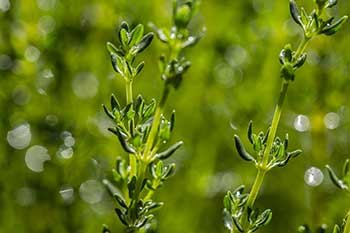
Thyme, like sage, grows best in full sun but prefers well-drained soil. It hates overwatering. Thyme is one of the most commonly used herbs in the world. You can grow it in your garden and use it fresh or dried in all kinds of dishes. The flowers, leaves, and oil are used as medicine. Thyme is sometimes used in combination with other herbs.
How to grow thyme
Sow seeds 5mm deep in a good potting mix. Sprinkle seeds on top of the soil. Do not bury the seeds, just let them lay on top. Gently press the seeds onto the soil using your finger.Water/spray the seeds lightly and do not overwater. Cover the top of the container with plastic. This will give the seeds a greenhouse effect and proper humidity. Transplant when it reaches 6 inches in height.


